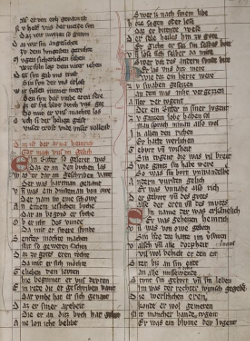Introduction
Hartmann's von Aue Der arme Heinrich only survives completely in three manuscripts. One of these (A) was burnt during the bombardment of Strassburg by German forces in August 1870, but is well-known from earlier transcripts and prints. Of the other two manuscripts, one (Bb) is a direct transcription of the other (Ba). In addition, there are three small fragments with 61 (C), 117 (D) and 177 (E) often incomplete verses respectively, as well as a pen-trial with 5 verses (F).
With the exception of manuscripts Ba and Bb, all sources display a comparatively high degree of text variation, including numerous verse switches, reductions, additions and alterations. These changes to each manuscript, whether complete or fragmentary, give the appearance of adaptations. The story being told is not fundamentally altered by these changes, but there are distinct accentuations and nuances that influence our historical understanding.
Academics have always been aware of these differences. In the 19th and early 20th centuries this problem was avoided by treating the version represented in manuscript A as the best one, being closest to the author’s original. At that time this text was considered to be authoritative, being “der Arme Heinrich”. In the second half of the 20th century this opinion became difficult to maintain, because it became clear that (despite the somewhat better quality of rhyming in A), it was impossible to decide which version was closer to the author’s original, or to exclude the fact that all manuscripts have been adapted. Philology as a discipline also moved away from the tendency to search for the text that most nearly matched the supposed original. Instead, the attempt was made to review all received versions as witnesses to historical readings and interpretations, and to thereby acknowledge their own intrinsic value. With a text such as Hartmann's armer Heinrich, which displays such strong contrasts in its historical transmission, it is not possible to decide which version is the most authentic or closest to the supposed original. At an early stage, perhaps from the very beginning, the story was “open”, or freely adaptable, or perhaps subject to more demands to be adapted. Each version claims for itself the position of the true Hartmann's armer Heinrich, and the validity of these claims cannot be decided. The work can only be understood historically by seeing the plurality or contemporaneity of each supposedly authentic version. Because it is not known how many versions of each manuscript exist, or even if the author himself produced more than one version, the only way for philology to approach this text is to acknowledge its variety and to make it available in one edition. Der arme Heinrich is not a text, or the text of one particular manuscript, but rather the totality of all existing versions reflecting their plurality and variety.
This leads though to the conclusion that when confronted with two diverging versions of the text, one cannot be simply excluded or relegated to the footnotes. For this reason, Kurt Gärtner in his edition of Der arme Heinrich for the Altdeutsche Textbibliothek (Old German Text Library), which followed convention by using manuscript A, decided to include the variations of other sources in new editions, either in the critical apparatus or even in the text itself. This did not though make the omissions and transpositions more visible. The new edition by Nathanael Busch and Jürgen Wolf published by Reclam went a step further, including from verse 971 onwards a reproduction of manuscript Ba printed on the lower half of the page.
The electronic edition of Der Arme Heinrich continues this process but goes considerably further, using the possibilities that the digital medium offers to make this flexibility of the text more visible. It offers the possibility to read and compare the various versions of the text, either individually or in parallel. The texts can be displayed either in the editorially revised version, or just as a transcription of the manuscript.

